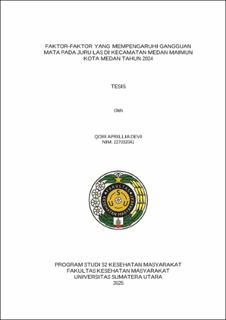| dc.description.abstract | Welding is a high-risk occupation that poses potential hazards to eye health,
thereby endangering workers. This study aimed to analyze the effects of ultraviolet
(UV) radiation exposure on eye health among welders in Medan Maimun Sub-
District, Medan City. The research employed a quantitative observational analytic
approach using a cross-sectional study design. The study was conducted in Medan
Maimun Sub-District, which has the highest concentration of welding businesses in
Medan City, from August 2024 to December 2024. The study population consisted
of all 85 welding businesses in the area. A sample of 25 welding businesses was
selected, involving 94 welders who met the inclusion criteria. Sampling was
conducted using a cluster sampling technique for the welding businesses and total
sampling for the welders. Data collection involved interviews, observations, and
measurements of UV radiation intensity carried out by technicians from the Medan
Occupational Health and Safety Center. Data analysis was conducted in three
stages: univariate analysis, bivariate analysis using simple logistic regression , and
multivariate analysis using multiple logistic regression with a 95% confidence level
(α=0.05). The results indicated that factors influencing eye disorders among
welders included UV radiation intensity (p-value=0.001; β=0.338), welding
machine current strength (p-value=0.001; β=0.022), and duration of exposure
during welding activities (p-value=0.019; β=0.051). The most dominant factor was
UV radiation intensity (p-value=0.001; β=0.338). Recommendations include, for
Welders use eye protection equipment that complies with established safety
standards. For Welding Business Owners implement clear Standard Operating
Procedures (SOPs) for the workshop area and ensure compliance among workers.
For the Labor Department of Medan City, Develop policies related to occupational
safety and health for welding workers. | en_US |


